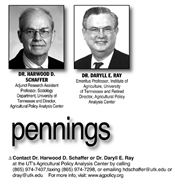|
Number And Size Measures Of US Farms—Some Surprising, Some Not

As we begin a new year, we want to look at some of the organizational and other characteristics of production agriculture in the US. The data we are using comes from the 2012 US Census of Agriculture (COA) which gives the most complete picture of US agriculture available.
While many believe that corporate ownership dominates US agriculture, the data show a different picture. Family ownership and partnerships account for 93.3 percent of the 2.1 million farms in the US, while corporations, estates, trusts, cooperatives, and other forms of ownership account for 6.7 percent.
The COA does not distinguish among the different possible forms of corporate ownership of farms, but from the discussions we have had with farmers it appears that most of this corporate ownership is composed of pass-through entities that allow farmers to simplify their taxes. Given the preferential treatment of pass-through entities in the recently adopted tax cut legislation, we expect to see more farmers reorganize their operations as pass-through entities.
Of the 2.1 million farms in the US, 813 thousand have fewer than 50 acres while 1.8 million have fewer than 500 acres. For a farmer in the developing world who farms less than 2.5 acres (1 hectare), 500 acres or even 50 acres may seem large, but in the US context most farms of this size derive a significant portion of their income from off-farm sources. At the other end of the size spectrum there are 173 thousand farms that are 1,000 acres or larger.
In the COA, farmers are classified as principal operators, second operators and third operators. There are 2.1 million principal operators and 3.2 million operators over all on the 2.1 million US farms. Of this number, 1 million are women with 288 thousand working as the principal operator of the farm.
Farming is the primary occupation of 1.4 million farm operators while 1.3 million work 200 days a year or more off farm. Sixty percent of principal operators work off farm.
The total value of products sold from US farms is $395 billion with an additional $8 billion coming from government payments. Contrary to popular belief, just 2 percent of gross farm income comes from government payments.
Reading “Charlotte’s Web” is probably as close as many people get to a farm. Based on reading that book one might expect every farm to grow multiple crops and raise a range of animals as well. And that was generally true a century ago. But today’s farm operations are far more specialized.
Corn for grain is grown on 349 thousand farms while soybeans are raised on 302 thousand farms. Wheat is grown on 148 thousand farms and 18 thousand farms grow cotton. These four crops account for 222 million acres.
Total cropland in the US is 390 million acres with 415 million acres in permanent pasture and rangeland. Woodland cover 77 million acres with the total land in farms coming to 915 million acres.
Of the nation’s 2.1 million farms 741 thousand sell cattle and calves while only 56 thousand sell hogs and pigs. Layers (for eggs) are on 198 thousand farms while 33 thousand have broilers.
There are few tariffs on imported agricultural products and, compared to a couple of decade ago, there are few export subsidies for agricultural products.
As a whole, US agriculture is very diversified. But, taking a cue from agricultural economists and similar changes in other sectors, farmers have identified those areas where they have a comparative advantage and then specialized. ∆
DR. HARWOOD D. SCHAFFER: Adjunct Research Assistant Professor, Sociology Department, University of Tennessee and Director, Agricultural Policy Analysis Center
DR. DARYLL E. RAY: Emeritus Professor, Institute of Agriculture, University of Tennessee and Retired Director, Agricultural Policy Analysis Center
|
|